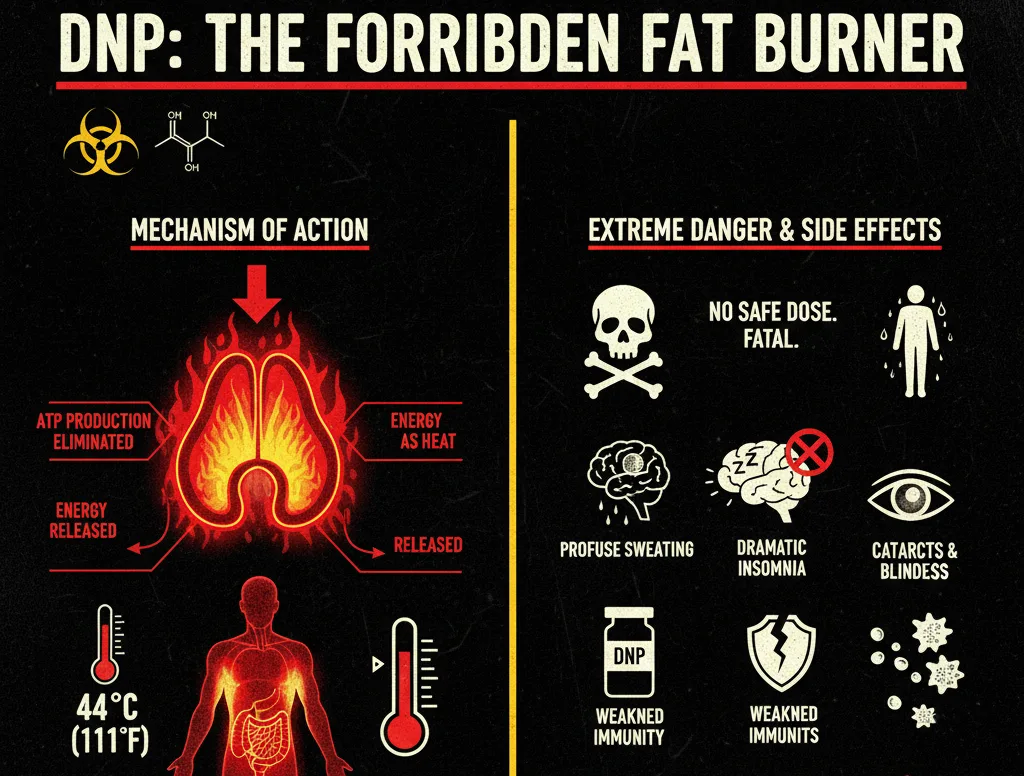Introduction
Dinitrophenol (DNP) is a synthetic chemical first used in industrial processes such as making dyes, wood preservatives, explosives, and pesticides. While it was never designed for human use, it gained infamy in the 1930s as one of the most powerful fat-burning agents ever discovered. Despite being banned nearly a century ago, underground labs still produce DNP today, leading to repeated cases of poisoning and death.
Historical Background
The fat-loss potential of DNP was discovered accidentally in France during World War II, when factory workers exposed to the chemical began losing weight rapidly. This observation led to its short-lived medical use as a weight-loss drug in the early 1930s. However, within just 3–4 years, reports of fatal overheating, blindness, and severe skin damage forced authorities to ban the compound worldwide. Some death reports were so severe that patients were described as having “burned from the inside.”
Mechanism of Action
DNP works by uncoupling oxidative phosphorylation in the mitochondria:
Normally, the food we eat is broken down into ATP, the body’s usable form of energy.
DNP disrupts this process, forcing mitochondria to burn nutrients without creating usable ATP.
Instead of energy storage, the fuel is released as heat.
This turns the body into a virtual “furnace,” dramatically increasing metabolic rate. Estimates suggest fat loss of 0.5 kg per day, or up to 4 kg per week, which is far beyond what is safe.
However, this same process drives body temperature dangerously high. Reports of internal temperatures exceeding 44°C (111°F) have been documented, often leading to organ failure and death.
Risks and Side Effects
Unlike many fat-loss aids, there is no safe dose of DNP. Even medically studied ranges (2–4.3 mg/kg/day for up to 6 weeks) were associated with severe risks.
Common side effects include:
-Extreme sweating (many users reported mattresses soaked nightly)
-Severe insomnia
-Nausea and vomiting
-Dehydration and heat intolerance
-Severe and life-threatening effects:
-Fatal hyperthermia (internal overheating)
-Cataracts and blindness
-Skin lesions and rashes
-Suppressed white blood cell count → weakened immunity
-Multi-organ failure
-There are multiple case reports of individuals dying after only a few doses.
Comparison to Other Fat Loss Drugs
While performance-enhancing communities often discuss compounds like Clenbuterol and Cytomel (T3) for fat loss, both are far safer than DNP (though not risk-free).
-Clenbuterol: Increases metabolic rate via beta-2 adrenergic stimulation.
-T3 (Cytomel): A thyroid hormone that regulates metabolic speed.
Neither reaches the raw fat-burning potential of DNP, but neither comes close to its lethality either. Importantly, unlike anabolic steroids, DNP has no muscle-building or strength-enhancing properties—it is purely a (dangerous) fat burner.
Why People Still Use It
Despite being banned for almost 90 years, DNP still circulates on the black market. Desperation for rapid fat loss leads some to risk their lives, but the outcome is unpredictable and often catastrophic. Deaths are still reported every year, even in young and otherwise healthy individuals.

